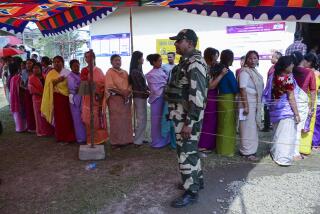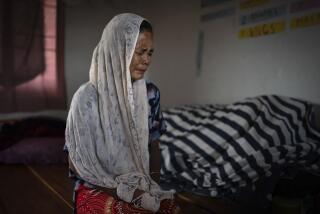In Manipur, India, hostilities persist despite blockade’s end
- Share via
Reporting from Keirao, India — Truck driver Rahman Anwar, 33, was on National Highway 39 in September when his vehicle was surrounded by protesters angry because he was breaking their economic blockade. They smashed his head with a boulder and he died days later without regaining consciousness.
On Tuesday, the Kuki tribal group voted to end its 92-day blockade of the road in remote Manipur state after the government agreed to consider establishing a new administrative district known as Sadar Hills, part of the Kuki community’s bid for greater autonomy.
During the blockade — which some say is the longest in Indian history — four people have been killed, 10 government buildings burned and Manipur residents have faced extensive shortages of fuel, food and medicine.
“We can only hope we’re the last family that has to suffer like this,” said Mohammad Anwar, 29, the slain truck driver’s brother.
Given the deep tribal, geographical and historical divisions in Manipur, however, few expect it to end there.
A rival group representing the Naga tribe vowed Tuesday to step up a “counter-blockade” it began in September of the only highway linking the isolated northeastern state with the rest of India. Its concern: Sadar Hills would be carved out of a majority Naga district. Distrust between the two groups extends at least as far back as the British Empire, when administrators were accused of drawing borders arbitrarily.
“We’re in a difficult position: If you give it, you have a problem; if you don’t give it, you have a problem,” said D.S. Poonia, Manipur’s chief secretary. “Everything here’s divided on ethnic lines. You can call it a madhouse, complex, challenging, take your pick.”
In addition to the Kuki-Naga differences, there is also wariness among residents of hill and valley communities, armed sectarian groups vying for independence, criminal gangs and politicians allied with various camps.
Further clouding the picture is a weak economy, endemic corruption, widespread drug use, frequent strikes and social upheaval.
Not surprisingly, ordinary people are the biggest losers.
“Gun violence, blockades, killings, you find it all in Manipur,” said Jimmy Leivon, a reporter with the Imphal Free Press newspaper. “I don’t see a solution. It’s pretty bleak.”
A few miles outside Imphal, the state capital, Rahman Anwar’s burned-out truck is one of several littering the road, its radial tires now bracelets of charred wire. The other deaths occurred when a protester’s rock struck a driver, who then lost control and crashed, killing her and both passengers.
The economic blockade has driven up prices in Manipur by as much as 300%, with gasoline selling for $12 a gallon, onions for 75 cents a pound, and potatoes for 30 cents a pound. Even without the counter-blockade, officials say, it would take weeks to restock shelves.
Some find it difficult to understand how a national highway could be blocked for months on end. But analysts say politics, ethnic differences and the unique sensitivities of India’s restive northeast work against tough law enforcement.
“The mob attacks us right in front of the police,” said Naobi Heman, 32, a driver fixing his vehicle by the roadside. “There’s no adequate protection.”
The blockade is a moving target. Road barriers pop up and disappear as lookouts relay intelligence on truck and security movements, allowing attackers to strike, then melt into the community.
Last month, a foreigner’s car was stopped by a woman who knew his identity even though he’d never seen her before.
“We usually think about the Cuban missile crisis and Israel-Palestine when we talk about blockades,” said H. Rajendra Singh, a retired economics professor. “Here it’s in our own country.”
Konthoujam Bilasini, 37, sits by the roadside outside Imphal selling gray market gasoline at an 80% markup, procured after waiting five hours in a gas line. Her profit, however, doesn’t make up for her higher food and school-bus costs, she said.
“It’s miserable as a housewife. Politicians, underground groups — they’re in cahoots and we’re the field hockey ball getting hit by both sides.”
At Imphal’s Divine Polytechnic Clinic along a muddy, pothole-marked road, laboratory director H. Yaiphaba, 35, has been forced to ration oxygen and saline solution since two medicine-laden trucks were burned.
“We’ve postponed many elective surgeries,” he said. “And we’ve stopped taking emergency cases, although fortunately no one’s died yet.”
As a disproportionate share of available food and fuel has gone to wealthier, better connected city dwellers, rural residents in Manipur are left to struggle.
Hevah Kipgen, 37, who runs a restaurant on a deserted stretch of highway, has watched her customer base and profit fall by 80%.
“I’m not happy with all this unrest,” she said, as a diner eats rice and curry with his hands. “But what can you do? If you say you’re angry, you’ll only get in trouble from one group or another.”
With classes constantly interrupted by transportation and general strikes, and various political groups holding demonstrations on school days, parents worry about their children’s future.
“We stay home, watch TV; classes are always stopped,” said Anusuya Chongtham, a college sociology student sipping tea in the school canteen.
Those vying for local government jobs have to pay $10,000 or more in bribes, social activist Rajkumar Ranendrajit said. “There’s no administration, no governance,” he said. “It’s a total system failure.”
Young people facing a bleak outlook can no longer afford to dream, said Amar Yumnam, dean of social sciences at Manipur University.
“They don’t know when they’re going to get killed,” he said. “This creates an enjoy-it-while-you-can mentality, leading to ethical problems, drag racing, drug use.”
As the blockade dragged on, the state government organized protective convoys for as many as 1,000 trucks, but this left trucks in the middle vulnerable.
“They’re sitting ducks,” said Anil Meitei, secretary of the All Manipur Road Transport Drivers’ and Motor Workers’ Union, and 250 drivers have been killed in the state since 1990 as a result of political instability or criminal attacks. “Whether from police [shakedowns], armed forces or agitators, drivers are always at the receiving end.”
At Anwar’s modest home in Keirao, a village near Imphal, family members quietly mourn. They described him as a conscientious, serious person who started as an apprentice at 13, becoming a full driver at 18. A decade ago, they said, he was kidnapped by insurgents, forcing the family to take out a large loan for his ransom.
As the family’s sole earner, he supported his parents, five siblings and his fiancee, whom he planned to marry once the loan was paid off. With his death, his two younger brothers and a sister may have to quit school.
Anwar made it through a 52-day blockade in 2005 and a 68-day blockade last year, both mounted by Naga groups: one in protest of the government’s declaration of June 18 as Integrity Day (a celebration by another group, the Meiteis, of an uprising that the Nagas found insulting), the other after the government tried to prevent a Naga official from entering Manipur. But in September, his luck ran out, his family said.
“He was such a good son,” said his father, Mohammad Mofijuddin, 60, beside a small vegetable patch and a muddy pond for bathing. “Why did this have to happen to us?”
More to Read
Sign up for Essential California
The most important California stories and recommendations in your inbox every morning.
You may occasionally receive promotional content from the Los Angeles Times.










